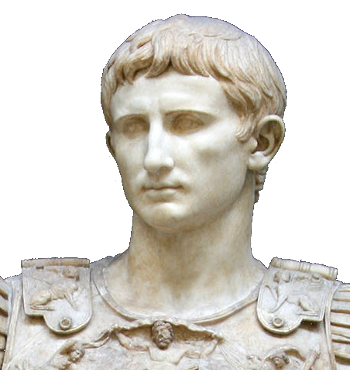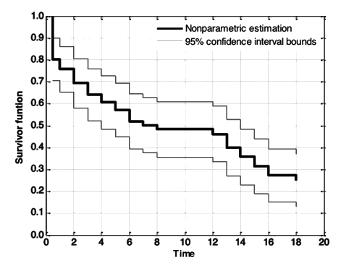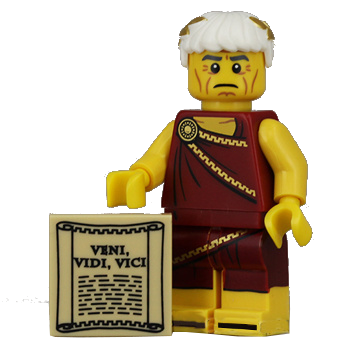When in Rome...
February 17, 2020
I have a definite dislike of
politics, a topic that excited my
father. If my father were still living, I'm certain he would be an ardent
Trump supporter, since he was genuinely excited about
Ross Perot's 1992 presidential campaign. One memorable
saying of my father was that he didn't want to be
President, he wanted to be
king. In that sense, he was talking about the
omnipotent kings of yesteryear and not today's
ceremonial monarchs. He wanted to be like a
Roman emperor, so he could have free reign to "clean things up."

The first Roman emperor, Augustus, Imperator Caesar Divi filius Augustus (63 BC - AD 14).
While Julius Caesar (100 BC - 44 BC) was assassinated at age 55, Augustus lived to be 75, the apparent victim of a poisoned fig.
This may have been an intentional suicide, since he was in failing health at the time and had prepared for a transition of power to Tiberius.
His final words were, "Behold, I found Rome of clay, and leave her to you of marble."
(Detail from the statue, Augustus of Prima Porta, via Wikimedia Commons. This 1,000 kg statue was discovered in 1863 at a villa owned by Livia Drusilla, Augustus’ third wife. It is now displayed at the Vatican Museum.)
As befits their position, Roman emperors had extreme
wealth, but they shared much of their wealth in order to maintain their
empire. They also staged
public spectacles to earn the respect of their people; and, in modern
corporate parlance, to amass
goodwill. Augustus, as recounted in
The Deeds of the Divine Augustus (Res Gestae Divi Augusti), staged
gladiatorial games, and
hunts of 3,500
African beasts, in the
Circus Maximus. In 18 BC, during a tax shortfall, Augustus gave contributions of grain and money to more than 100,000 men.
Also written in the Res Gestae Divi Augusti are specific
monetary outlays that allow us to estimate the wealth of Augustus as compared to modern
moguls. Augustus gave 150,000,000
sestertii to the
Senate treasury, and 170,000,000 to the
military treasury. His total contributions to all causes were 2,400,000,000 sestertii. Since you could buy a
loaf of
bread for half a
sestertius, we can value a sestertius at about $5.00; so, this outlay is 12 billion dollars. If we assume that this was 10% of his wealth, the
net worth of Augustus is estimated as $120 billion. For comparison, this is almost exactly the net worth of
Amazon's Jeff Bezos.

The total donations of Roman emperor, Augustus (Imperator Caesar Divi filius Augustus), to the Roman Empire. "All the expenditures which he gave either into the treasury or to the Roman plebs or to discharged soldiers: HS 2,400,000,000." (From The Deeds of the Divine Augustus (Res Gestae Divi Augusti). English translation and Latin text from refs. 1 and 2).[1-2]
Augustus had much wealth, considerable
fame, and a long life. With only this example, it seems as if everyone, not just my father, would want to be an emperor. They might reconsider after reading a
paper on the
longevity of Roman emperors by
Joseph Homer Saleh, an associate professor of
Aerospace Engineering at the
Georgia Institute of Technology.[3-4] As an
aerospace engineer, Saleh knows the important topics of
failure analysis and
survival analysis, and the
statistical analysis of
component failure using the
Weibull distribution. He's applied such analyses to the Roman emperors.
There were 69 rulers of the unified Roman Empire, starting with Augustus and ending with
Theodosius, who died in 395 AD. Forty-three of these (62%) suffered a
violent death in
combat, by the more common assassination, or by suicide.[3-4] Compare this with a present day
dangerous activity,
Himalayan mountain climbing, for which
climbers who ascend eight
kilometers have a
risk of death by
accident of about 4%, which is an
order of magnitude lesser risk of violent death than being a Roman emperor.[3] This high
probability of an early death is known, but what hasn't been studied is whether there is an underlying
pattern in the length of each emperor's reign, and this is the topic of Saleh's study.[4]
Saleh
analyzed the statistics of Roman emperor longevity using tools used to assess the
reliability of aerospace components. The analysis showed that there was a
parallel between component and emperor longevity.[3-4]
Data for the emperors was found in
De Imperatoribus Romanis, a
peer-reviewed online encyclopedia of the Roman emperors.[4] It was found that the length of an emperor's reign, the time from the beginning of their reign until death, followed a set pattern that's similar to what's seen in reliability engineering.[4] One feature is
infant mortality; that is, the tendency for some components, and also emperors, to die early in their service.[4]

Survival of Roman emperors as a function of years in office.
At seven years, a Roman emperor had just a 50:50 chance of having a violent death.
(Fig. 2 of ref. 3, licensed under the Creative Commons Attribution 4.0 International License. Click for larger image.)
An emperor's risk of death stabilized by the eighth year, but increased again after 12 years of rule.[4] This pattern is that same for component failure, since components are subjected to
fatigue,
corrosion, and
wear.[4] Data for the "failure rate" of Roman emperors followed a
bathtub-like curve that's seen in the failure of
electrical components and
mechanical components.[4] Says Saleh,
"In engineering, the reliability of a component or process is defined as the probability that it is still operational at a given time. The time it takes for a component or process to fail is referred to as its time-to-failure and this shows similarities to the time-to-violent-death of Roman emperors... It's interesting that a seemingly random process as unconventional and perilous as the violent death of a Roman emperor--over a four century period and across a vastly changed world--appears to have a systematic structure remarkably well captured by a statistical model widely used in engineering. Although they may appear as random events when taken singularly, these results indicate that there may have been underlying processes governing the length of each rule until death."[4]

Roman Emperor Lego® figure. From the inscription, it would be Julius Caesar.
Pieces from the popular Lego® construction sets are made from acrylonitrile butadiene styrene (ABS), a plastic with excellent physical and mechanical properties.
2 x 2 Lego® bricks (the ones with four coupling cylinders) have a mass of 1.152 grams, and they can withstand an average compression force of 4,240 newtons. You can build a two mile high tower of these bricks without having material failure from compression.[5]
(Image from brickdisplaycase.com, used with permission.)
References:
- Augustus, "The Deeds of the Divine Augustus," 14 AD, Thomas Bushnell, Trans. (1998. Copyright 1998, Thomas Bushnell, BSG. This translation may be freely distributed, provided the copyright notice and this permission notice are retained on all copies.
- Res Gestae Divi Augusti, Latin text of "The Deeds of the Divine Augustus," from William L. Carey's Latin Library.
- Joseph Homer Saleh, "Statistical reliability analysis for a most dangerous occupation: Roman emperor," Palgrave Communications vol. 5, article no. 155 (2019), doi:10.1057/s41599-019-0366-y. This is an open access article with a PDF file here.
- Time-to-death of Roman emperors followed distinct pattern, Springer Press Release, December 22, 2019.
- Ruth Alexander, "How tall can a Lego tower get?" BBC News, December 4, 2012.
Linked Keywords: Politics; father; Donald Trump; Ross Perot's 1992 presidential campaign; saying; President of the United States; king; omnipotence; omnipotent; ceremonial monarch; Roman emperor; Augustus, Imperator Caesar Divi filius Augustus (63 BC - AD 14); Julius Caesar (100 BC - 44 BC); assassination; assassinated; poison; poisoned; fig; suicide; disease; failing health; Tiberius; Behold, I found Rome of clay, and leave her to you of marble; statue; Augustus of Prima Porta; Wikimedia Commons; kilogram; kg; villa; Livia Drusilla; wife; Vatican Museum; wealth; Roman Empire; public spectacle; corporation; corporate; parlance; goodwill; Res Gestae Divi Augusti; The Deeds of the Divine Augustus; gladiator; gladiatorial; game; hunting; hunt; African; animal; beast; Circus Maximus; money; monetary; business magnate; mogul; sestertius; sestertii; HS; Roman Senate; treasury; military; loaf; bread; net worth; Amazon.com; Amazon; Jeff Bezos; donation; Roman plebs; military discharge; soldier; English language; translation; Latin; fame; academic publishing; paper; longevity; Joseph Homer Saleh; Aerospace Engineering; Georgia Tech; Georgia Institute of Technology; aerospace; engineer; failure analysis; survival analysis; statistical analysis; reliability engineering; component failure; Weibull distribution; Theodosius I; homicide; violent death; combat; hazard; dangerous; Himalayas; Himalayan; mountain climbing; mountaineering; climber; kilometer; mortality rate; risk of death; accident; order of magnitude; probability; pattern; analysis; analyze; correlation; parallel; data; De Imperatoribus Romanis; peer review; peer-reviewed; Internet; online; encyclopedia; infant mortality; longevity; survival; chance; Creative Commons Attribution 4.0 International License; material fatigue; corrosion; wear; bathtub curve; electrical component; mechanical component; process; mean time between failures; MTBF; time-to-failure; randomness; random process; peril; perilous; century; Lego®; popularity; popular; construction set; acrylonitrile butadiene styrene (ABS); plastic; physical and mechanical properties; cylinder (geometry); mass; gram; compression force; newton; tower; brickdisplaycase.com.